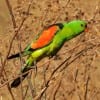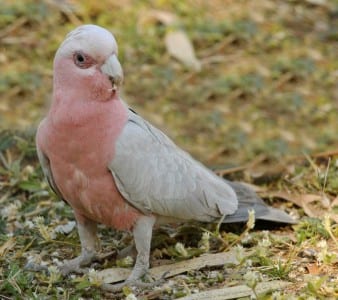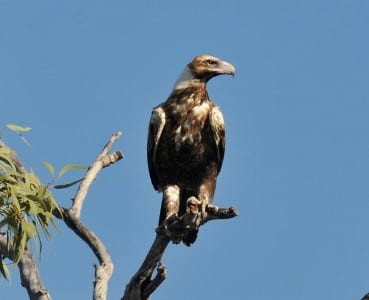 by Jim Stevenson,
by Jim Stevenson,
Seeds are an amazing source of energy and nutrition for birds and other animals and there is a lot of them in Australia’s Outback. Here, there are parrots of two species and a lovely dove, all enjoying a handful of seeds the local cook threw out. What follows is the list of seed-eaters we have seen while zipping through the Aussies back yard.

One of my favorite Aussie birds is the Apostlebird, wandering throughout the Outback and especially tinytowns on the Savannah Way. First curiously named for their habit of being in flocks of a dozen or so, these forage the ground for fallen seeds and fruit as well.




Everybody in Australia loves the Galah, a large, pink parrot that’s often tame and abiding. We gringos might call it a “gay’ lah” but the Aussies have named it “gay LAH.” You know the old joke; we have the emPHAsis on the wrong sylLAble. These were picking up seeds right in the middle of town, and virtually all towns have them.

Chestnut-breasted Finches are common in loose flocks in fields and pastures. It’s funny how they and Zebra Finches seem to emerge from nowhere and suddenly congregate in large, dense flocks in bushes and wires. These males join many Aussie finches as being quite colorful while the females are adapted for camouflage on the nest.

took us a while to find Star Finches but they are in irrigation ditches in Western Australia, where seeds and water are available. The red face is unmistakable and their notes are like a will, It a dead giveaway. The bright colors of so many finches are supported by the high energy found in seeds.

If the budgies aren’t enough for you, here’s a flock of cockatiel hanging out on a dead Mulga tree in the Outback. While budgies have great cryptic coloration in the canopy’s leaves, these birds hide extremely well on dead wood. Both species are fast as greased lightning and quite noisy when predators approach. Now, here’s one up close:


A beautiful bird of the Outback is the Crested Pigeon, which flies like an accipiter and maintains subtle colors for the observant. Australia actually has two doves with pointed heads and scientists think these (like the quail of our Desert Southwest) are there to imitate sticks and thorns to help the birds hide.

Hidingin thick plant growth are Double-barred Finches, pretty little guys with white faces, dotted wings and blue bills. They prefer the more moist forests in the Outback and usually are found with their own species. Species that live in thorns and other prickly sites make it harder for predators to hunt them, an old trick of snake around the world.


Chestnut-breasted Manikins are not native to Australia but pretty well established. They fit right into the other flocks of colorful finches and also wander into more humid areas like eastern Australia. I have seen these in three other continents.

Peaceful Doves are quiet residents of the Outback and beyond, with lovely blue faces and gentle coos. They are also found in cities where they remind me of the Inca Doves that do well at the feeders in Texas. Small doves are especially desired by small falcons and accipiters – when they can catch them!

Pheasant Coucals are beautiful cuckoos of the Outback that even have sexual dimorphism and seasonal change. They scoop up seeds off the forest floor and also take fruit and insects for a balanced diet. Coucals are a group of Southern Hemisphere cuckoos with large size and interesting ways.

The Lord of the Outback is the mighty Wedge-tailed Eagle with this brown immature showing off its massive bill. This species gets blacker with age and older birds look quite wicked. I’m sure there will be more pictures of this species as Liz and I work Western Australia. Regrettably, a fair number of wedgies get hit by trucks on highways ofthe Outback, while feeding on carcasses of wallabies and kangaroos.

The Aussies also have a small group of huge, black parrots called black cockatoos, with this Red-tailed Black-cockatoo widespread in the Outback. They devour huge amounts of seeds and fruit and make an even greater amount of noise when approached.

The beautiful Rainbow Lorikeet brings color (and noise!) to the Outback, looking more like a bird of a rain forest. This one is eating various parts of a flower butthey are often seen on the ground eating seeds and other plant material. They are joined by other species of Lorikeets, a common group of parrots Down Under.

The raucous Sulfur-crested Cockatoo shows off his crest at all opportunities and seems to have little fear of any birds. They get very tame around human dwellings but can be quite wary in the middle of the Outback. Cockatoos are larger than corellas and other parrots in Australia and widely held in the captive bird world.

Zebra Finches are often found in large flocks in the Outback, issuing their quiet little squabbly note and assembling in large groups off the ground. Like most Aussie finches they exhibit strong sexual dimorphism and reproduce like crazy. During this time, of course, they incorporate more protein in their diet, often with insects.

 Posted in
Posted in 
























